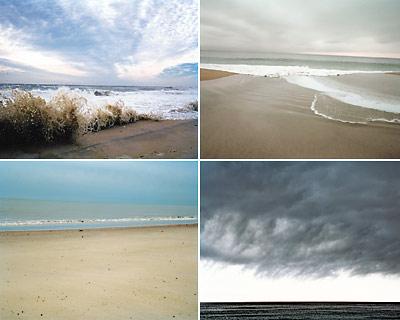Beach Show-Stoppers for All Seasons

The first thing one notices when leafing through Tria Giovan’s new book “Sand Sea Sky: The Beaches of Sagaponack,” is the quiet.
These are not the sunny, overly dramatic images of roaring waves or electric-blue skies or other things we’ve come to expect from our photographic interactions with the sea. Even when a storm gathers such strength as to be a coal-black cloud hanging ominously above a calm but ebon sea, the effect is show-stopping but static. We sense the impending power of the storm, but it seems to be caught in equipoise, a fleeting threat not yet exercising its full force, or about to dissipate as quickly as it has arisen.
There is a moody grayness that permeates every image, whether taken in the cold pale light of winter or the intense sun of midsummer. Activity is captured, but frozen as if time is slowing down.
The wonderful thing is how calming these images are. It is just you, the viewer, and the sea, an increasingly rare phenomenon here, even in the winter. It reminds us not of the days of high-keyed Technicolor enjoyment we are programmed to wait for like starved children each spring, but of the constancy of being here, day in and day out, a seasonless witnessing and vigil.
Ms. Giovan, who grew up on St. Thomas in the Virgin Islands with summers spent at the ocean in Rhode Island, and who has had a house in Sag Harbor for 15 years, is uniquely well suited to understand what makes our beaches so different from others.
“I was always near the beach,” she said. The Caribbean’s bright, intense colors mixed with its crowds, cars, dogs, roosters, and lively music to produce hectic, non-stop noise. “Getting to Rhode Island, we would breathe a sigh of relief.”
She loved the contrast of the two worlds. “The Northeast’s soft colors and waves were so soothing. . . . It became imprinted on my psyche that when I leave a city I go to the beach. It is a place of refuge: safe, quiet, calm, different.”
The moment being fleeting, when Ms. Giovan sees something she wants to capture, she seizes it. “The subject is not static, and so my movement was very fluid. It became almost a dance.” Although she tried to keep a Zen-like calm, “I was often moving frenetically to catch those moments.”
Of the storm photo, she said, “I love to swim, but I wanted to capture the image, so I was jumping in the water and jumping out to take the photo, jumping in and jumping out again.” It was summer and “when a storm comes up like that you can feel the energy in the air. It’s very tactile.”
Her images became collections such as one might gather of shells or other mementos of a beach visit. “I could always find something to take, and I was never bored. They may not have been significant enough to have been included, like seaweed or sand being blown by the wind. Then there are those real obvious times, like when there was the black sky and it’s incredible and your heart’s racing. Then, there’s just no question that there is this great confluence of elements and energy.”
She was compelled to return again and again to the beach, she said, and realized after four or five years that it was time to get more serious about her work. She has accumulated over a decade’s worth of photos now.
While the book notes say the images cover all three miles of Sagaponack beach, Ms. Giovan said her favorite was Gibson Lane. “I always go to Gibson and always walk to the right or walk to the left. I don’t know what it is about Gibson, other people say it too, ‘I can only go to Gibson.’ And there’s this core group of people who gravitate to this one place.”
She still uses film, but does scan her negatives. To print large, it has become the best option, she said. Printing large in the darkroom leads to too much dust on the print and a laborious cleanup process. A scan helps the photographer to see what is really there and pull it out in a way that the traditional printing process cannot.
“You can see all that is there in the negative. You can’t always get that out of a print,” Ms. Giovan said. “You’re not printing anything that isn’t already there,” the detail is just enhanced by the process.
A prior book, “Cuba: The Elusive Island,” was published in 1996. Her work has also appeared in publications such as Aperture, Elle, Esquire, Harper’s, Travel & Leisure, and Vogue, and is in the collections of several museums, including the Museum of Modern Art and the Brooklyn Museum.
The book, which includes an essay by Carl Safina, was published by Damiani Editore and is for sale at the Clic Bookstore and Gallery in East Hampton and in New York City. A number of large-format prints from the book will be on view at the gallery beginning on June 30, with a reception and book signing from 5 to 8 p.m.
